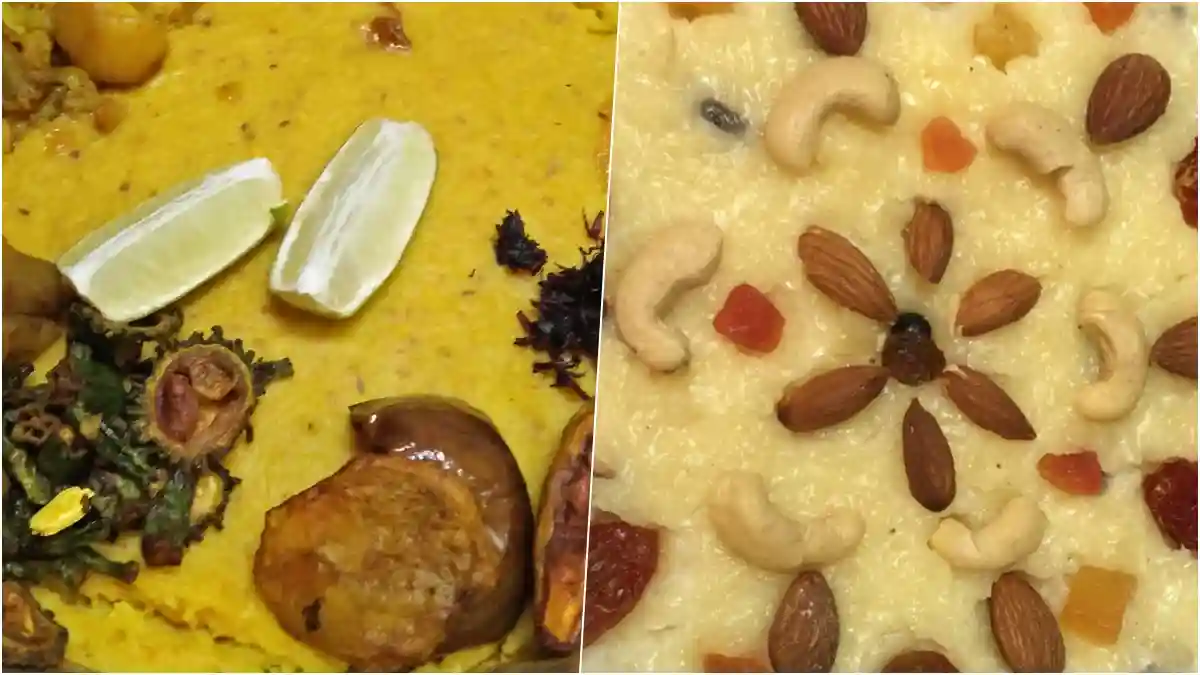Durga Puja 2025 Bhog Recipes: Traditional Dishes From Khichuri to Payesh To Prepare and Offer to Goddess Durga
By Meera
Copyright latestly

Durga Puja is an auspicious Hindu festival dedicated to the worship of Goddess Durga. The festival is celebrated with great zeal and devotion, especially in eastern India, like in West Bengal, Assam, Odisha, Tripura, and Bihar, marking the victory of Goddess Durga over the buffalo demon Mahishasura. The Durga Puja celebrations usually last for ten days, with the important days being the last five days known as Shashthi, Saptami, Ashtami, Navami, and Vijayadashami. Durga Puja 2025 starts on September 27 with Panchami and ends with Vijayadashami on October 2. Durga Puja 2025 Start and End Dates: When Is Mahalaya, Durga Ashtami, Maha Navami and Vijaydashami? Check Date-Wise Full Schedule of Bengali Durga Puja. Durga Puja is incomplete without its traditional bhog, an offering that brings together flavours and devotion. This traditional bhog is served to Goddess Durga and then distributed among devotees during the Durga Pujo festivities. The Durga Puja is a simple yet soul-satisfying meal that reflects Bengal’s culinary traditions, where thousands come together to relish the sacred meal. Durga Puja Inscribed on the UNESCO Intangible Heritage List. Khichuri One of the famous bhoj re Khichuri, a fragrant preparation made with gobindobhog rice and moong dal, cooked to perfection with ghee and mild spices. Unlike the everyday khichdi, this festive version is rich yet sattvic, offering both comfort and celebration in every bite. Khichuri (Photo Credits: Wikimedia Commons) How to make Khichuri: Wash the rice and dal together. For extra flavour, you can lightly dry roast the dal before washing. Heat ghee or oil in a pressure cooker/pan. Add bay leaf, cumin seeds, and slit green chilli. Add potato cubes and other vegetables, and saute for 2–3 minutes. Add the washed rice and dal, stir gently. Add turmeric powder, salt, and about 3 cups of water. Pressure cook the dal for 2–3 whistles. Once done, open the lid, give it a gentle stir and adjust the water. Labra Accompanying it is Labra, a wholesome medley of seasonal vegetables like pumpkin, brinjal, potato, and beans, slow-cooked together with mustard oil and panch phoron. The harmony of flavours in Labra complements the Khichuri beautifully, making it a quintessential part of the bhog platter. Labra (Photo Credits: Wikimedia Commons) How to cook Labra: Heat mustard oil in a pan/kadhai until it smokes lightly. Lower the flame. Add bay leaf and panch phoron, let them splutter. Add slit green chillies and ginger paste, sauté for 1 minute. Add all the chopped vegetables together, sprinkle turmeric and salt, and mix well. Cover and cook on low-medium flame (no need to fry separately) – the veggies will release water and cook in their own steam. Stir occasionally; if it gets too dry, add 2–3 tbsp water. Once the vegetables are soft and mashed slightly, add a pinch of red chilli powder for flavour and mix well. Finish with a drizzle of mustard oil for an authentic taste. Bengali-style Chutney One of the other important side dishes is the sweet and tangy Chutney. Usually made with tomatoes or seasonal fruits like pineapple or mango, it adds a delightful contrast to the otherwise savoury meal. Bengali-style Chutney (Photo Credits: Wikimedia Commons) How to make Bengali-style Chutney Heat mustard oil in a pan. Add dry red chilli and panch phoron, let it splutter. Add the chopped tomatoes and a pinch of salt. Cook until they turn soft and pulpy. Add dates, raisins, and sugar. Mix well. Pour in ½ cup water and simmer for 7–8 minutes until the chutney thickens and gets a glossy texture. Taste and adjust the sweetness as you like. Payesh The sweetness balances the spice, preparing the palate for the grand finale – Payesh. This creamy rice pudding, made with milk, rice, and jaggery or sugar, is a symbol of prosperity and auspiciousness, and its presence in the bhog signifies abundance and blessings. Payesh (Photo Credits: Wikimedia Commons) How to make Payesh: To make Payesh, you need to wash the rice thoroughly and keep it aside. Boil the milk in a heavy-bottomed pan with bay leaf and cardamom. Stir often so it doesn’t stick. When the milk reduces a little, add the rice and cook on a low flame and keep stirring it occasionally. Once the rice is soft and the milk has thickened, add sugar. Mix well and cook for 5 more minutes. In a small pan, heat ghee and lightly fry cashews and raisins (if using). Add them to the payesh. Turn off the heat and let it rest – it thickens more as it cools. Beyond these staples, bhog may also include fried treats like beguni (batter-fried brinjal slices), crisp papad, and mishti (traditional Bengali sweets), depending on the community or household. Together, these dishes transform the bhog into more than just food. For devotees, savouring the bhog is as spiritual an experience as witnessing the rituals of Durga Puja itself.



